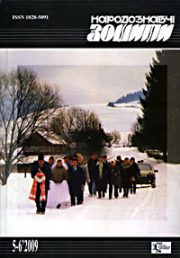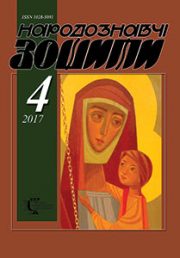The Ethnology Notebooks. 2025. № 5 (185), 1264—1287
UDK398.801.8/.82-94::001.89(477)”372.363/.364:15/20″
DOI https://doi.org/10.15407/
RECORDING FOLKLORE IN EXTREME CONDITIONS / DURING THE WORK PROCESSES WITH INCREASED RISK (on the lecture at the meeting of the Folklore Commission of the Shevchenko Scientific Society within the events for the Day of Science in Ukraine (2025, May 27))
IVANNIKOVA Liudmyla
- ORCID ID: https://orcid.org/0000-0003-0617-5082
- Candidate of Sciences in Philology (PhD), Senior Researcher,
- M. Rylsky Institute for Art Studies, Folkloristics and Ethnology
- of the National Academy of Sciences of Ukraine,
- the Department of Ukrainian and Foreign Folklore Studies,
- 4, Hrushevskoho St., 01001, Kyiv, Ukraine,
- Contacts: e-mail: ivannikovafolk@ukr.net
LIASHENKO Liana
- School leaver, winner of the Junior Academy of Sciences
- of Ukraine in the section «Folklore Studies» (on the 3rd final)
- stage — in 2024—2025, on the 2nd (Kyiv) stage — in 2023—2024 and 2024—2025)
- Contacts: e-mail: liashenkoliana2008@gmail.com
BROVARETS Tetiana
- ORCID ID: https://orcid.org/0000-0003-1563-2572
- Candidate of Sciences in Philology (PhD),Researcher,
- M. Rylsky Institute for Art Studies, Folkloristics and Ethnology
- of the National Academy of Sciences of Ukraine,
- the Department of Ukrainian and Foreign Folklore Studies,
- 4, Hrushevskoho St., 01001, Kyiv, Ukraine,
- Contacts: e-mail: tetiana.volkovicher@gmail.com
Abstract. The current article has been prepared based on the materials of a three-part lecture heard and discussed at the May meeting of the Folklore Commission of the Shevchenko Scientific Society, which took place as part of the events for the Day of Science in Ukraine — 2025. The co-speakers which are Liudmyla Ivannikova (The first part «Conservation of folklore in the Budbat context in the preserved documents of the Cossack era»), Liana Liashenko (The second part «Social and cultural models of the folk beliefs formation and transformation in the communities of military personnel and rescuers of the State Emergency Service of Ukraine»), Tetiana Brovarets (The third part «Eliminating the consequences of hostilities in the ranks of Dobrobat. Contexts that make the working day and their impact on folklore creating») have discussed the overdue issue of preserving folklore in extreme conditions / during the work processes with increased risks to the life and health of workers.
The purpose of such a somewhat innovative association was to draw the attention of the Society, as well as the general public, to the urgent need to preserve as much as possible those folklore units, the detection of which at the first stages is particularly laborious because of the conditions where and when they function: in closed communities, often directly during the performing work tasks associated with increased danger. Additional complications for further work with such material are the so-called fragmentation (or intermittency) of fixations, as a result of which we obtain the so-called incomplete (or partial) texts. However, the above challenges should not hinder the study of the object, as they only enhance its research attractiveness. The extreme conditions of (re)creation of folklore largely determine its uniqueness. All these aspects — both of the texts themselves and of the contexts that are closely interconnected — are worth many in-depth studies. This is quite realistic to achieve provided that the ranks of volunteer fixers are replenished with new generations.
The preservation of folklore in working, particularly extreme, contexts should be encouraged by both professional folklorists/ethnologists and all concerned citizens who show a desire and readiness to take a direct part in eliminating the consequences of Russian armed aggression.
Keywords: folklore fixation in extreme conditions; (working) contexts; folklore creating; recorder positions «from inside» and «from outside»; fortifiers of the Cossack era; military personnel; rescuers of the State Emergency Service of Ukraine; volunteers of Dobrobat; participant observation; «incomplete» texts; «fragmentary» fixations.
Received 30.08.2025
REFERENCES
- Malyshev, Oleksandr. (2021). Theodoric the Great’s Legislation on Protection of Monuments and the Significance of the Ostrogothic Renaissance in the Context of Heritage Law History. Constitutional State, 32, 166—178. Retrieved from: https://jnas.nbuv.gov.ua/article/UJRN-0001262686 [in Ukrainian].
- (2025, May 27). The meeting of the Folklore Studies Commission of the Shevchenko Scientific Society. Folklore Studies Commission of the Shevchenko Scientific Society: YouTube channel. Retrieved from: https://youtu.be/vRgAi2pIjx4?si=mWx_GiPfYCBP8_D4 [in Ukra inian].
- Demediuk, Maryna. (2025, May 27). At the May meeting of the Folklore Commission of the Shevchenko Scientific Society, we discussed the peculiarities of recording folklore in extreme conditions. During the work processes with increased risks. Folklore Studies Commission of the Shevchenko Scientific Society: Facebook page. Retrieved from: https://www.facebook.com/groups/1087950299056083/posts/1431868617997581/ [in Ukrainian].
- Malyshev, Oleksandr. (2019, July 17). International Law and «bloody antiquities»: new challenges and prospects (Public seminar within the National festival of science «Archaeology in occupied territories and war zones». Kyiv: Union of Archaeologists of Ukraine and Institute of Archaeology of the NAS of Ukraine, 2019, May 16). Wild Fox: YouTube channel. Retrieved from: https://www.youtube.com/watch?v=toPS47RdowI [in Ukrainian].
- Telizhenko, Serhii (Ed.), Smyrnov, Oleksandr, & Hrechko, Denys. Archaeological remains and war. A guide to the protection of cultural values for the Ukrainian Armed Forces personnel who conduct operational tasks to counter Russian aggression in the East of Ukraine. 2020. Retrieved from: https://www.vgosau.kiev.ua/txt/SAU_war.pdf?fbclid=IwY2xjawKykDBleHRuA2FlbQIxMABicmlkETFtNDJKYXNaTkRyUlVIb2tCAR7VkdMwoluQgcpbYZy2m1tP91RHwgp0jeOkCgYKpkXFqDj-wpwA5lcsLV8F4A_aem_9EWlOL4jczuaGQy6JojLLg [in Ukrainian].
- Malyshev, Oleksandr. (2020). Protection of cultural heritage in the occupied territories of Ukraine. Law of Ukraine, 11, 110—126. DOI: 10.33498/louu-2020-11-110 [in Ukra inian].
- Brovarets, Tetiana. (2023). Field work in the ranks of the volunteer building battalion (Dobrobat). War, Science and Emotions: (Un)New Concepts and Approaches. Proceedings of the Round Table (Chernihiv, 2023, February 21—22) (Pp. 102—105). Kyiv [in Ukrainian].
- Brovarets, Tetiana M. (2025). Folklorist’s Fieldwork While Eli minating the Consequences of Hostilities: on the Author’s Experience in the Ranks of a Volunteer Building Battalion Dobrobat, Kyiv and Chernihiv divisions, Ukraine, 2022—2024. Proceedings of Online Seminar «Preservation of Folklore in Modern Archives: Field Research and Documentation Issues in the Context of European Practices» (Tartu — Kyiv, 2025, April 25). Tartu. Retrieved from: https://www.kirmus.ee/index.php/en/research/seminars.
- Chabai, Viktor. (2023, November 10). Archaeology of Ukraine during the war: challenges and prospects (Press conference «Archaeology of Ukraine during the war: challenges and prospects». Kyiv: Ukrainian Crisis Media Center, November 10, 2023). Ukrainian Media Center: YouTube channel. Retrieved from: https://www.youtube.com/watch?v=iTce4fd6iD4 [in Ukrainian].
- (2024, December 21). General Staff of the Armed Forces of Ukraine (Official Facebook page of the General Staff of the Armed Forces of Ukraine). A unit for the protection of cultural heritage has been created in the Armed Forces of Ukraine. Retrieved from: https://www.facebook.com/GeneralStaff.ua/posts/pfbid0KeDG7PsiAch1BWhAFA5THgv64oRNTber4ZbmeQwCjjj8GFpvtLqJoUAXNfUHdwnwl [in Ukrainian].
- (2025, March 24). Taras Shevchenko National University of Kyiv. Preservation of cultural heritage in wartime: a special course for the military personnel. Retrieved from: https://knu.ua/ua/news/13544 [in Ukrainian].
- Brovarets, Tetiana. (2024). Working program of the academic discipline «Folklore transmissions while eliminating the consequences of Russian armed aggression (Based on field work materials in ranks of the volunteer building battalions)» for postgraduate students in the specialty 035.09 «Folklore Studies» (number of credits/modules — 3, total number of hours — 90). Kyiv: Maksym Rylskyi Institute for Art Studies, Folkloristics and Ethnology of the National Academy of Sciences of Ukraine [in Ukrainian].
- Ivannikova, Liudmyla. (2013). Narrative tradition of the Zaporozhian Sich in the middle of the 18th century in Fixing by Luka Yatsenko-Zelenskyi. Bulletin of Zaporizhzhia National University: Collection of Scientific Works. Philological Sciences, 2, 37—42. Retrieved from: https://web.znu.edu.ua/herald/issues/2013/2013-fil-2.pdf [in Ukrainian].
- Ivannikova, Liudmyla. (2015). The first fixations of Zaporizhzhia folklore in the descriptions of travelers of the 17th—18th centuries. Bulletin of Zaporizhzhia National University: Collection of Scientific Works. Philological Sciences, 2, 58—67. Retrieved from: https://web.znu.edu.ua/herald/issues/2015/2015-fil-2.pdf [in Ukrainian].
- Ivannikova, Liudmyla. (2015). «The story of the Zaporozhian Cossacks» by Symeon Myshetskyi as a source for the study of the folklore of the 17th—18th centuries. Slavic World, 14, 46—76. Retrieved from: https://ss.etnolog.org.ua/wp-content/uploads/2022/11/ivannikova-2.pdf [in Ukrainian].
- Ivannikova, Liudmyla. (2013). The ritual of farewell to the world in Zaporizhzhia and Taras Shevchenko’s poem «The Monk». Word and Time, 11, 3—11. Retrieved from: https://dspace.nbuv.gov.ua/bitstream/handle/123456789/149448/03-Ivannikova.pdf?sequence=1 [in Ukrainian].
- Ivannikova, Liudmyla. (2015). «How to make a fool of a Muscovite»: adventures of Cossacks in the folklore plots of the 17th—21st centuries about Cossack stories adventures. Word and Time, 10, 76—85. Retrieved from: https://il-journal.com/index.php/journal/article/view/415 [in Ukrainian].
- Ivannikova, Liudmyla. (2016). Mythologization of the image of Zaporozhian Cossack in the folklore of the 18th and 19th centuries: from criminal to sorcerer. Word and Time, 1, 67—75. Retrieved from: https://il-journal.com/index.php/journal/article/view/221 [in Ukrainian].
- Sokulskyi, A. (Ed.). The diary of Erich Lassota von Steblau (1594). (2003). Zaporizhzhia Antiquities (Pp. 222—227). Kyiv; Zaporizhzhia: Research Institute of Cossackdom; ZaporizhzhiaBranch [in Ukrainian].
- Polonska-Vasylenko, Nataliya. (1965). Zaporizhzhia of the 18th century and its heritage (Vol. 1) Munich: Dnieper Wave. Retrieved from: https://194.44.152.155/elib/local/sk/sk575974.pdf [in Ukrainian].
- Bovhyria, Andrii. (2002). «The story of the Zaporozhian Cossacks» by Symeon Myshetskyi in the historical thought of the second half of the 18th century. Historiographical Studies in Ukraine, 11, 303—317. Retrieved from: https://history.org.ua/JournALL/graf/graf_2002_11/26.pdf [in Ukrainian].
- Beauplan, Guillaume Levasseur. (1990). A description of Ukraine, containing several provinces of the Kingdom of Poland, lying between the confines of Moscovia, and the borders of Transylvania. Kyiv: Naukova dumka; Cambridge: Ukrainian Scientific Institute. Retrieved from: https://litopys.org.ua/boplan/opys.htm [in Ukrainian].
- Dmytro Yavornytskyi. Dnieper rapids. (2022, May 29). (Part 1: Videobook (The work «Dnieper Rapids» by Dmytro Yavornytskyi was first published in 1928) Flash Life: YouTube channel. Retrieved from: https://www.youtube.com/watch?v=hG-C16R4OiI [in Ukrainian].
- Volkovicher, Tetiana. (2019). Verbal texts in folk embroidery of the late 19th till the first half of the 20th century: Monograph. Kyiv: Naukova dumka. Retrieved from: https://www.etnolog.org.ua/pdf/stories/monografiji/2019/volkovicher.pdf [In Ukrainian].
- Vlasov, Oleh. (2018). Dnieper rapids. Kharkiv: Publisher Oleksandr Savchuk. Retrieved from: https://docs.google.com/viewer?url=https%3A%2F%2Fshron1.chtyvo.org.ua%2FVlasov_Oleh%2FPorohy_Dnipra.pdf [in Ukrainian].
- Naumovska, Olesia. (2025, March 20). The comment during the discussion of reports at the International Scientific and Practical Conference «Preservation of National Heritage and Development of Cultural Practices in the Face of Social Challenges (to the 130th Anniversary of the Birth of Maksym Rylsky)». Kyiv [in Ukrainian].
- Liashenko, Liana. (2024). Mechanisms of the superstitions’ formation: the phenomenon of modern military communities. Kyiv: Kyiv Junior Academy of Sciences of Ukraine [in Ukrainian].
- Liashenko, Liana. (2025). Sociocultural models of the beliefs’ formation and transformation in the professional community of rescuers of the State Emergency Service of Ukraine. Kyiv: Kyiv Junior Academy of Sciences of Ukraine [In Ukrainian].
- Liashenko, Liana. (2025). Collection of beliefs among rescuers of the State Emergency Service of Ukraine. Kyiv [in Ukrainian].
- Liashenko, Liana. (2025). Ethnographic map of beliefs in the State Emergency Service of Ukraine. Kyiv. Retrieved from: https://goo.gl/maps/BUH5tKJK57pB9EsWA?g_st=ac [in Ukrainian].
- Kuzmenko, Oksana. (2023). The comment during the discussion of reports at the roundtable conference «War, Science and Emotions: (Un)New Concepts and Approaches» (Chernihiv; Kyiv, February 21—22, 2023). Chernihiv Travel: YouTube channel. (2023, February 24). Retrieved from: https://www.youtube.com/watch?v=EPEVbZRqfCY#t=05h18m54s [in Ukrainian].
- Dobrobat history. Retrieved from: https://www.dobrobat.in.ua/history/epizod-pershyj/ [in Ukrainian].
- Dobrobat is a volunteer building battalion. Retrieved from: https://www.dobrobat.in.ua/ [in Ukrainian].
- (2013, August 21). On approval of the Regulation on volunteer civil protection units. Resolution of the Cabinet of Ministers of Ukraine, 616. Retrieved from: https://zakon.rada.gov.ua/laws/show/616-2013-%D0%BF#n10 [in Ukrainian].
- Tereshchenko, Oleksandr. (2023). General aspects of criticizing the modern field recordings of Ukrainian musical folklore. Issues of Ethnomusicology, 18, 32—41. Retrieved from: https://doi.org/10.31318/2522-4212.2023.18.294827 [in Ukrainian].
- Britsyna, Olesia. (2003). Modern aspects of the methodology for collecting folk prose. Folk Art and Ethnology, 4, 24—34. Retrieved from: https://nte.etnolog.org.ua/arkhiv-zhurnalu/2003-rik/3/1613-nauka-i-suchasnist/2791-suchasni-aspekty-metodyky-zbyrannia-narodnoi-prozy [in Ukrainian].
- Malyshev, Oleksandr. (2015). Historical development of the Swedish legislation on the archaeological heritage protection (XVII—ХХІ). Constitutional State, 26, 43—52. Retrieved from: https://pravova-derzhava.org/en/assets/images/issues/26/pravova-derjava-26-2015.pdf#page=43 [in Ukrainian].
- Malyshev, Oleksandr. (2016). Historical development of the Mexican archaeological law. Constitutional State, 27, 72—81. Retrieved from: https://jnas.nbuv.gov.ua/article/UJRN-0000744802 [in Ukrainian].
- Koval-Fuchylo, Iryna. (2021). The main values in the narratives about resettlement from the flooded areas. Folk Art and Ethnology, 4 (392), 51—63. Retrieved from: https://nte.etnolog.org.ua/arkhiv-zhurnalu/2021-rik/4/2254-rozvidky-ta-materialy/4442-osnovni-tsinnosti-v-opovidiakh-pro-pereselennia-iz-zon-zatoplennia.
- Koval-Fuchylo, Iryna. (2022). The concept of cemetery in memories about resettlement from the flood zone. Slavia Orientalis, 3 (Vol. LXXI, pp. 509—525). Retrieved from: https://journals.pan.pl/dlibra/publication/142776/edition/125270/content [in Ukrainian].







